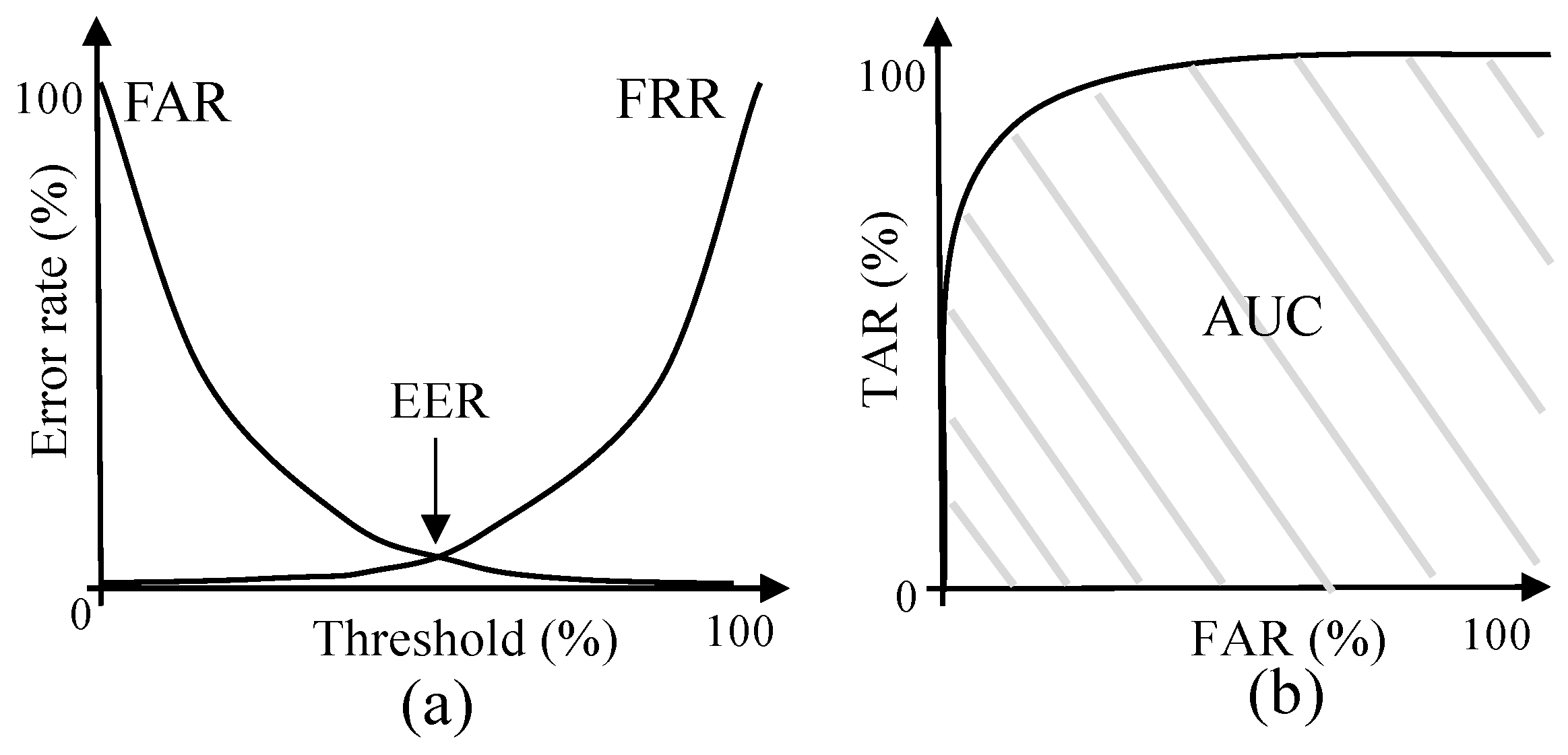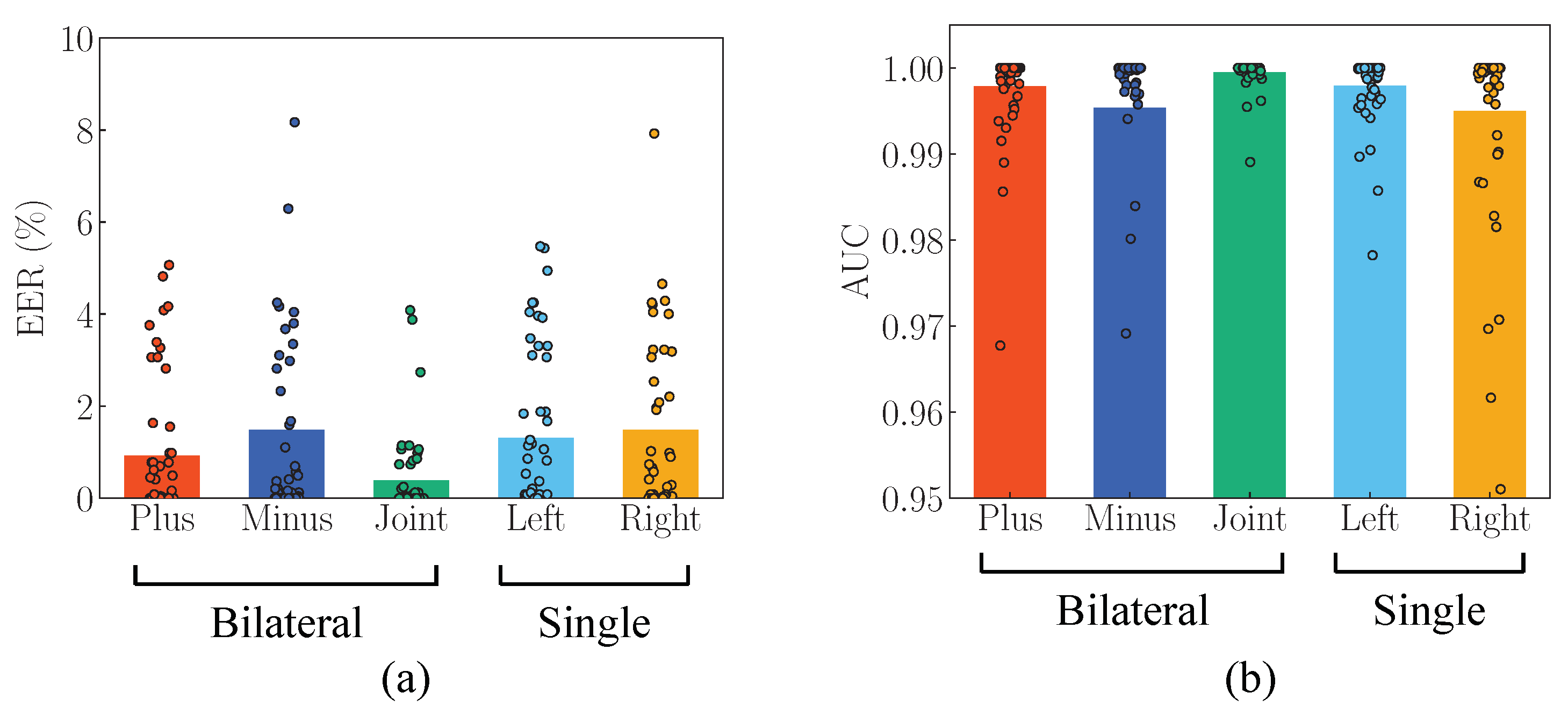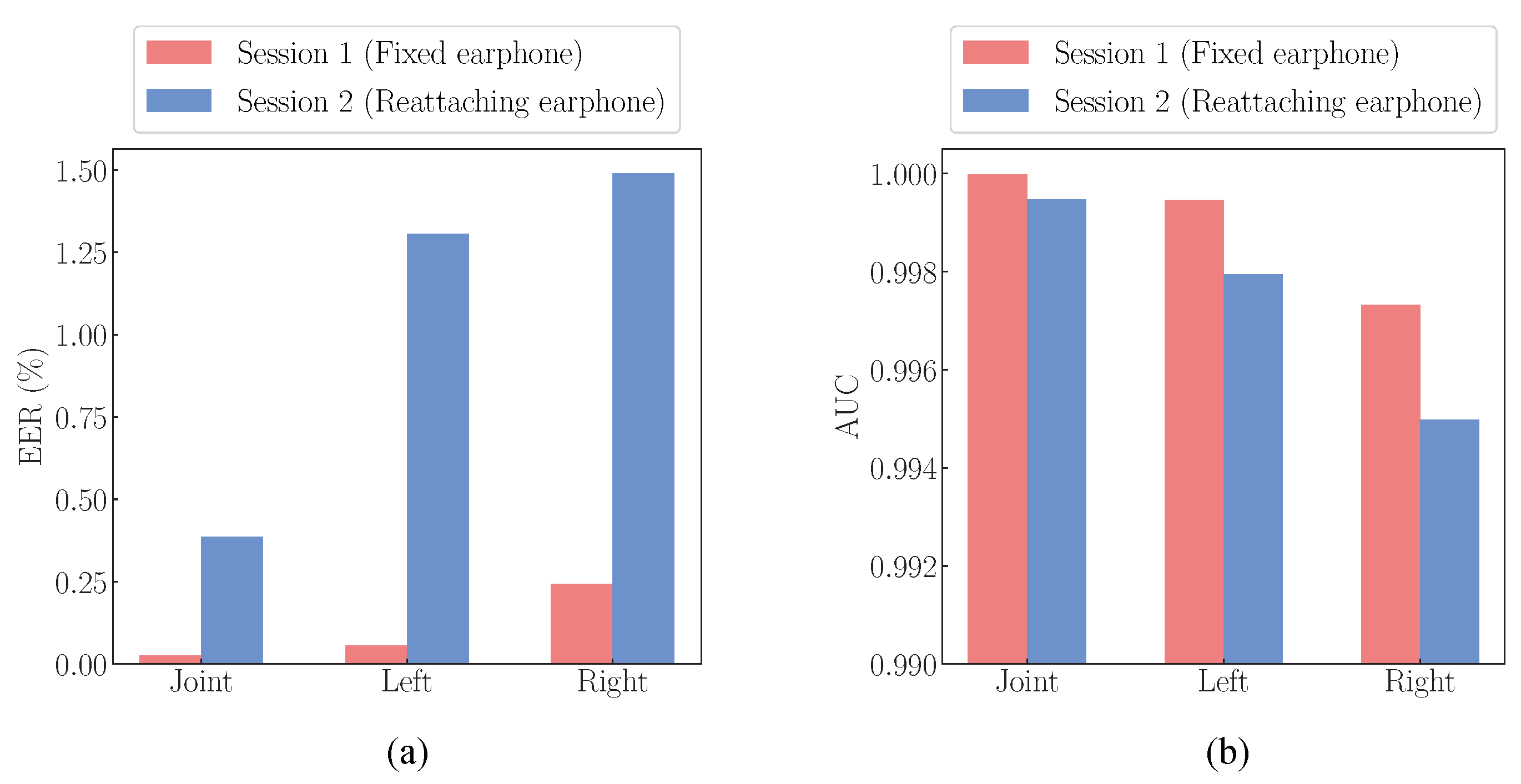Bilateral Ear Acoustic Authentication: A Biometric Authentication System Using Both Ears and a Special Earphone
Abstract
1. Introduction
2. Ear Acoustic Authentication
3. Data Acquisition
3.1. Subjects
3.2. Measurement and Preprocessing
4. Analysis of Bilateral Signals
4.1. Visualization
4.2. Cosine Similarity
5. Evaluations
5.1. Bilateral Ear Acoustic Authentication System
5.2. Factors of Evaluation
5.3. Classification
5.4. Feature Extraction for Bilateral Data
5.5. Result
6. Discussion
6.1. Efficacy of Bilateral Ear Acoustic Authentication
6.2. Deterioration of Authentication Accuracy by Minus Method
6.3. Exclusion of Low SNR Data
6.4. Issues for Practical Use
7. Conclusions
Author Contributions
Funding
Institutional Review Board Statement
Informed Consent Statement
Data Availability Statement
Conflicts of Interest
References
- Jain, A.; Ross, A.; Prabhakar, S. An introduction to biometric recognition. IEEE Trans. Circuits Syst. Video Technol. 2004, 14, 4–20. [Google Scholar] [CrossRef]
- Lu, G.; Zhang, D.; Wang, K. Palmprint recognition using eigenpalms features. Pattern Recognit. Lett. 2003, 24, 1463–1467. [Google Scholar] [CrossRef]
- Zhang, D.; Shu, W. Two novel characteristics in palmprint verification: Datum point invariance and line feature matching. Pattern Recognit. 1999, 32, 691–702. [Google Scholar] [CrossRef]
- Zhao, W.; Chellapa, R.; Phillips, P.; Rosenfeld, A. Face recognition: A literature survey. ACM Comput. Surv. 2003, 35, 399–458. [Google Scholar] [CrossRef]
- Thomas, T.; George, A.; Devi, K.I. Effective Iris Recognition System. Procedia Technol. 2016, 25, 464–472. [Google Scholar] [CrossRef][Green Version]
- Borgen, H.; Bours, P.; Wolthusen, S.D. Visible-Spectrum Biometric Retina Recognition. In Proceedings of the 2008 International Conference on Intelligent Information Hiding and Multimedia Signal Processing, Harbin, China, 15–17 August 2008; pp. 1056–1062. [Google Scholar]
- Campbell, J. Speaker recognition: A tutorial. Proc. IEEE 1997, 85, 1437–1462. [Google Scholar] [CrossRef]
- Yang, J.; Chen, J.; Su, Y.; Jing, Q.; Li, Z.; Yi, F.; Wen, X.; Wang, Z.; Wang, Z.L. Eardrum-Inspired Active Sensors for Self-Powered Cardiovascular System Characterization and Throat-Attached Anti-Interference Voice Recognition. Adv. Mater. 2015, 27, 1316–1326. [Google Scholar] [CrossRef] [PubMed]
- Fratini, A.; Sansone, M.; Bifulco, P.; Cesarelli, M. Individual identification via electrocardiogram analysis. Biomed. Eng. Online 2015, 14, 78. [Google Scholar] [CrossRef] [PubMed]
- Yano, S.; Arakawa, T.; Koshinaka, T.; Irisawa, H. Peoposal of authentication method by acoustical characterstics of ear canal. In Proceedings of the Fifth Symposium on Biometrics, Recognition and Authentication(SBRA), Tokyo, Japan, 12–13 November 2015; pp. 94–95. [Google Scholar]
- Moriya, N.; Kaneda, Y. Optimum signal for impulse response measurement that minimizes error caused by ambient noise. J. Acoust. Soc. Jpn. 2008, 64, 695–701. [Google Scholar]
- Yano, S.; Arakawa, T.; Koshinaka, T.; Imaoka, H.; Irisawa, H. Improving Acoustic Ear Recognition Accuracy for Personal Identification by Averaging Biometric Data and Spreading Measurement Errors over a Wide Frequency Range. IEICE Trans. 2017, J100-A, 161–168. [Google Scholar]
- Mahto, S.; Arakawa, T.; Koshinaka, T. Ear Acoustic Biometrics Using Inaudible Signals and Its Application to Continuous User Authentication. In Proceedings of the 26th European Signal Processing Conference, Rome, Italy, 3–7 September 2018. [Google Scholar]
- Gao, Y.; Wang, W.; Phoha, V.V.; Sun, W.; Jin, Z. EarEcho: Using Ear Canal Echo for Wearable Authentication. Proc. ACM Interact. Mob. Wearable Ubiquitous Technol. 2019, 3, 81:1–81:24. [Google Scholar] [CrossRef]
- Henrik, M. Fundamentals of binaural technology. Appl. Acoust. 1992, 36, 171–218. [Google Scholar]
- Wenzel, E.M.; Arruda, M.; Kistler, D.J.; Wightman, F.L. Localization using non-individualized head-related transfer functions. J. Acoust. Soc. Am. 1993, 94, 111–123. [Google Scholar] [CrossRef] [PubMed]
- Jens, B. Spatial Hearing; MIT Press: Cambridge, MA, USA, 1997. [Google Scholar]
- Yano, S.; Hokari, H.; Shimada, S. A Study on the Personal Difference in the Transfer Functions of Sound Localization Using Stereo Earphones. IEICE Trans. Fundam. 2000, E83-A, 877–887. [Google Scholar]
- Platt, J.C. Probabilistic Outputs for Support Vector Machines and Comparisons to Regularized Likelihood Methods. In Advances in Large Margin Classifiers; MIT Press: Cambridge, MA, USA, 1999; pp. 61–74. [Google Scholar]
- Wu, T.F.; Lin, C.J.; Weng, R.C. Probability Estimates for Multi-Class Classification by Pairwise Coupling. J. Mach. Learn. Res. 2004, 5, 975–1005. [Google Scholar]
- Pedregosa, F.; Varoquaux, G.; Gramfort, A.; Michel, V.; Thirion, B.; Grisel, O.; Blondel, M.; Prettenhofer, P.; Weiss, R.; Dubourg, V.; et al. Scikit-learn: Machine Learning in Python. J. Mach. Learn. Res. 2011, 12, 2825–2830. [Google Scholar]
- Chang, C.C.; Lin, C.J. LIBSVM: A library for support vector machines. ACM Trans. Intell. Syst. Technol. 2011, 2, 27:1–27:27. [Google Scholar] [CrossRef]












| Cosine Similarity | |
|---|---|
| Left | 0.985 |
| Right | 0.988 |
| Left–Right | 0.915 |
Publisher’s Note: MDPI stays neutral with regard to jurisdictional claims in published maps and institutional affiliations. |
© 2022 by the authors. Licensee MDPI, Basel, Switzerland. This article is an open access article distributed under the terms and conditions of the Creative Commons Attribution (CC BY) license (https://creativecommons.org/licenses/by/4.0/).
Share and Cite
Yasuhara, M.; Nambu, I.; Yano, S. Bilateral Ear Acoustic Authentication: A Biometric Authentication System Using Both Ears and a Special Earphone. Appl. Sci. 2022, 12, 3167. https://doi.org/10.3390/app12063167
Yasuhara M, Nambu I, Yano S. Bilateral Ear Acoustic Authentication: A Biometric Authentication System Using Both Ears and a Special Earphone. Applied Sciences. 2022; 12(6):3167. https://doi.org/10.3390/app12063167
Chicago/Turabian StyleYasuhara, Masaki, Isao Nambu, and Shohei Yano. 2022. "Bilateral Ear Acoustic Authentication: A Biometric Authentication System Using Both Ears and a Special Earphone" Applied Sciences 12, no. 6: 3167. https://doi.org/10.3390/app12063167
APA StyleYasuhara, M., Nambu, I., & Yano, S. (2022). Bilateral Ear Acoustic Authentication: A Biometric Authentication System Using Both Ears and a Special Earphone. Applied Sciences, 12(6), 3167. https://doi.org/10.3390/app12063167






